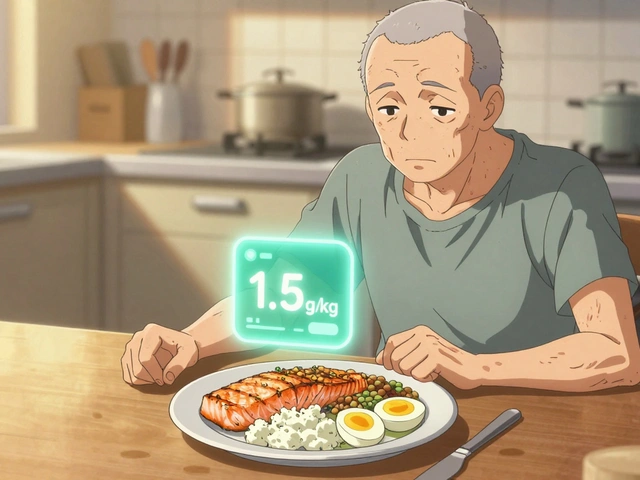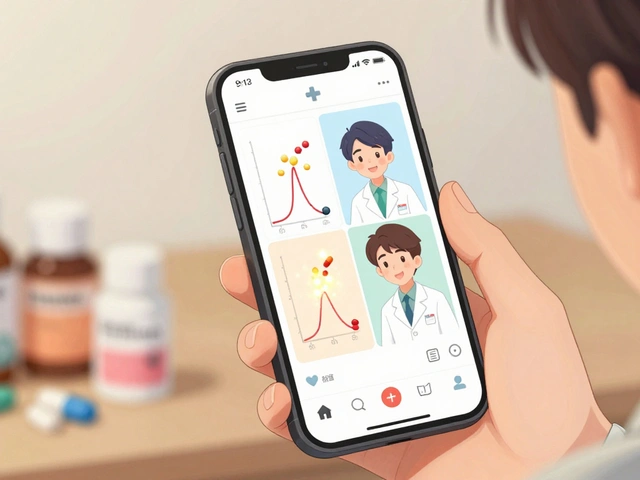When you’re diagnosed with hormone receptor-positive breast cancer, your doctor will likely talk about hormone therapy. It’s not chemotherapy. It doesn’t make your hair fall out. But it can be just as life-changing. For many women, taking a daily pill for five to ten years becomes part of their new normal. And two drugs - tamoxifen and aromatase inhibitors - are at the heart of that decision. Which one is right for you? It’s not just about which works better. It’s about your body, your life, and what side effects you’re willing to live with.
How Hormone Therapy Stops Breast Cancer From Coming Back
Not all breast cancers are the same. About 8 out of 10 are fueled by estrogen. These are called hormone receptor-positive cancers. The cancer cells have receptors that grab onto estrogen like a key in a lock. That signal tells the cells to grow. Hormone therapy blocks that signal. It doesn’t kill cancer cells. It starves them.
Tamoxifen and aromatase inhibitors do this in different ways. Tamoxifen acts like a fake key - it fits into the estrogen receptor but doesn’t turn it on. It blocks real estrogen from getting in. Aromatase inhibitors, on the other hand, shut down the body’s main source of estrogen after menopause. They stop the enzyme aromatase from turning male hormones into estrogen. Less estrogen means less fuel for the cancer.
Studies show both drugs cut the risk of cancer returning by about a third over 15 years. That’s not small. It’s the difference between a 20% chance of recurrence and a 13% chance. For many women, that’s the difference between seeing grandchildren grow up and not.
Tamoxifen: The Long-Standing Choice
Tamoxifen has been around since the 1970s. It’s the original. It’s cheap - generic versions cost less than $15 a month. It works for both premenopausal and postmenopausal women. That’s important because if you’re still having periods, aromatase inhibitors won’t work unless you also shut down your ovaries.
It’s taken daily, usually 20 mg. You swallow it like a vitamin. It stays active in your body for days after you miss a dose. That’s helpful if you’re traveling or forget one day.
But tamoxifen isn’t without trade-offs. It can increase the risk of blood clots. A small number of women develop deep vein thrombosis or pulmonary embolism. It also raises the risk of endometrial cancer - about 1.2% over 10 years compared to 0.4% for women not taking it. That’s why annual pelvic exams are recommended. It can also cause hot flashes, night sweats, and mood swings. Some women say it makes them feel like they’re going through menopause early - even if they’re not there yet.
On the bright side, tamoxifen protects your bones. It doesn’t cause bone thinning like aromatase inhibitors do. It may even slightly lower cholesterol. And for women who are premenopausal, these benefits matter. Your body still needs estrogen for bone and heart health.
Aromatase Inhibitors: The New Standard for Postmenopausal Women
Aromatase inhibitors - anastrozole, letrozole, and exemestane - became the go-to for postmenopausal women in the early 2000s. Why? Because they work better. The data is clear. In women who no longer have functioning ovaries, AIs reduce the risk of cancer coming back by 30% more than tamoxifen over five years. That’s not a tiny improvement. It’s a game-changer.
They cut estrogen levels by 95% or more. In postmenopausal women, almost all estrogen comes from fat tissue, not the ovaries. That’s where aromatase does its job. Block it, and you starve the cancer.
But the cost is higher. These drugs cost $100-$150 a month, even with insurance. Generic versions are cheaper, but still more than tamoxifen. And the side effects? They’re different. And often harder to live with.
Joint pain is the big one. Half of women on AIs report stiff, achy joints - knees, hands, hips. Some describe it as arthritis that came out of nowhere. A 2023 survey of over 1,200 women found 68% had moderate to severe joint pain on AIs, compared to 32% on tamoxifen. For some, it’s bad enough to quit. About 22% stop taking AIs because of it.
Then there’s bone loss. AIs speed up calcium loss from bones. After five years, 6.4% of women on AIs break a bone. That’s compared to 5.1% on tamoxifen. That’s why doctors check your bone density every year or two with a DEXA scan. If your bone score drops below -2.0, you’ll likely be put on a drug like zoledronic acid or denosumab to protect your bones.
Cardiovascular risk also goes up slightly. AIs can raise cholesterol and blood pressure. For women with heart disease or risk factors, this matters. Tamoxifen, in contrast, may slightly protect the heart.

What If You’re Still Having Periods?
If you’re premenopausal, aromatase inhibitors alone won’t work. Your ovaries are still making estrogen. So if your doctor suggests an AI, they’ll also give you ovarian function suppression - usually with goserelin (Zoladex), a shot under the skin every month or every three months. This puts you into temporary menopause.
That’s a big step. It means hot flashes, night sweats, vaginal dryness, and bone loss - all at once. But for women with higher-risk cancer, it’s worth it. The TEXT and SOFT trials showed that for women with intermediate or high risk, combining exemestane with ovarian suppression reduced recurrence risk to 6.9% over five years, compared to 10.1% with tamoxifen alone. That’s a 3.2% absolute reduction - meaning one extra recurrence prevented for every 31 women treated this way.
But it’s not for everyone. If your cancer is low-risk - small, slow-growing, no lymph node involvement - tamoxifen alone is still the standard. The side effects of ovarian suppression can be brutal. And for younger women, preserving fertility and avoiding early menopause matters.
Choosing Between Them: It’s Personal
There’s no one-size-fits-all answer. The decision isn’t just medical - it’s personal. Some women prioritize avoiding recurrence at all costs. Others prioritize quality of life.
Let’s say you’re 52, postmenopausal, with a small, low-grade tumor. Your doctor says both tamoxifen and anastrozole are options. Anastrozole gives you a slightly better chance of staying cancer-free. But you’ve had knee replacements. You’re worried about joint pain. You don’t want to be on calcium pills and bone shots for the rest of your life. Tamoxifen might be the better fit - even if the numbers are a little less perfect.
Or you’re 45, premenopausal, with a larger tumor and lymph node involvement. Your doctor says you need ovarian suppression. You’re not ready for early menopause. You’re scared of the side effects. But you know if you don’t do this, the cancer could come back. You choose exemestane plus the shot - because you want to be here for your kids’ graduations.
There’s no right answer. Only the right answer for you. That’s why guidelines now say: shared decision-making. Your values matter as much as the data.
What About Taking It Longer Than Five Years?
Five years used to be the standard. Now, many women take it longer - up to 10 years. Especially if your cancer was high-risk or came back after a previous treatment.
For tamoxifen, some women take it for five years, then switch to an AI for another five. Others stay on tamoxifen the whole time. For AIs, the common path is five years upfront, then extending with the same drug or switching to tamoxifen.
The data shows extended therapy reduces recurrence even more. But it also means more years of side effects. That’s why doctors use tools like the IBIS II risk calculator. It looks at your age, tumor size, grade, lymph node status, and genomic test results to estimate your personal risk. If your 10-year recurrence risk is still above 15%, extending therapy makes sense. If it’s below 10%, the extra benefit might not be worth the toll.
What’s Next? New Drugs on the Horizon
The field isn’t standing still. In 2023, the FDA approved camizestrant, a new type of hormone drug called a selective estrogen receptor degrader (SERD). Unlike tamoxifen or AIs, it doesn’t just block estrogen - it destroys the receptor itself. Early trials show it works better than AIs in women whose cancer has developed resistance to standard therapy.
There’s also research into testing your genes. Tamoxifen needs to be converted into its active form by an enzyme called CYP2D6. Some people have a genetic variation that makes this conversion slow. For them, tamoxifen might not work as well. A trial called CYRILLUS is testing whether checking for this gene before starting treatment can improve outcomes.
And there’s the question of duration. The PERSEPHONE trial is asking: Do you really need five years of tamoxifen? Could three years be enough for low-risk patients? If so, that’s fewer side effects and lower cost.
Real Lives, Real Choices
One woman in Sydney, 58, chose anastrozole after her lumpectomy. She had joint pain so bad she couldn’t hold her grandchild. She switched to tamoxifen after two years. The pain faded. She still gets hot flashes, but she’s back to gardening.
Another, 42, with a high-risk tumor, chose exemestane plus goserelin. She went into early menopause. She takes calcium, vitamin D, and a bone drug. She’s on a low-impact exercise plan. She says it’s hard, but she’d do it again. "I don’t want to leave my husband alone," she told her support group.
There’s no perfect choice. But there is a right one - for your body, your life, and your future.
Is tamoxifen still used today?
Yes. Tamoxifen remains the standard for premenopausal women and is still used in postmenopausal women who can’t tolerate aromatase inhibitors. It’s also the only hormone therapy approved for male breast cancer. It’s widely used because it’s effective, affordable, and has benefits for bone and heart health that AIs don’t offer.
Can you switch from tamoxifen to an aromatase inhibitor?
Yes. Many women start with tamoxifen for 2-3 years, then switch to an AI for the remaining 2-7 years. This approach, called sequential therapy, is common and supported by studies like the DATA and MA.17X trials. It can reduce side effects early on while still getting the long-term benefit of stronger estrogen suppression.
Do aromatase inhibitors cause weight gain?
Weight gain isn’t directly caused by aromatase inhibitors, but it’s common among women taking them. This is likely because menopause - whether natural or induced by treatment - slows metabolism and changes fat distribution. Studies show women on AIs gain about 1-2 kg more than those on tamoxifen over five years, mostly around the abdomen. Diet and exercise help manage this.
What happens if I stop hormone therapy early?
Stopping early increases your risk of cancer returning. The benefit of hormone therapy builds over time. Missing even a few months can reduce its effectiveness. If side effects are too hard to manage, talk to your doctor. There are ways to adjust - lower doses, switching drugs, adding medications for joint pain or hot flashes - without quitting entirely.
Are there natural alternatives to tamoxifen or aromatase inhibitors?
No. There are no proven natural alternatives that work as well as tamoxifen or aromatase inhibitors for preventing breast cancer recurrence. Supplements like soy isoflavones or black cohosh may help with hot flashes, but they don’t block estrogen’s effect on cancer cells. Relying on them instead of prescribed therapy can be dangerous. Always talk to your oncologist before trying anything new.
How do I know if I’m a good candidate for an aromatase inhibitor?
You’re a good candidate if you’re postmenopausal and have hormone receptor-positive breast cancer. Your doctor will also consider your bone health, heart health, joint pain history, and personal risk factors. If you have osteoporosis, a history of blood clots, or severe joint issues, tamoxifen might be safer. Genomic tests like Oncotype DX can also help - if your score is low, the benefit of AIs over tamoxifen may be small.
Can men take tamoxifen for breast cancer?
Yes. Male breast cancer is almost always hormone receptor-positive. Tamoxifen is the only hormone therapy approved for men. It works the same way - blocking estrogen receptors. Men typically take it for five years. Side effects include hot flashes, reduced libido, and erectile dysfunction, but it’s still the most effective option to prevent recurrence.
What to Do Next
If you’re facing this decision, don’t rush. Ask for a copy of your pathology report. Know your tumor’s hormone receptor status, grade, and whether lymph nodes are involved. Ask about genomic testing - Oncotype DX or Prosigna - to see if you really need chemotherapy on top of hormone therapy.
Make a list of your priorities. Is avoiding bone fractures more important than a 2% lower recurrence risk? Are hot flashes tolerable, but joint pain a dealbreaker? Bring this list to your next appointment. Bring a friend. Write down questions.
Hormone therapy isn’t a one-time decision. It’s a years-long journey. You’ll need check-ups, blood tests, bone scans, and maybe adjustments. But it’s also one of the most powerful tools we have to turn breast cancer from a life-threatening illness into a manageable condition.





Jessica Healey
November 17, 2025 AT 06:26So I switched from anastrozole to tamoxifen after 18 months because my joints felt like they were ground glass?? And honestly? Best decision of my life. Still get hot flashes but I can hold my dog without wincing. Also, no more bisphosphonates. My bones are fine. I’d do it again.
Kelsey Robertson
November 17, 2025 AT 17:15Let me just say this: the entire medical-industrial complex is pushing AIs because they’re profitable. Tamoxifen’s been around since Nixon. Why? Because it’s dirt cheap. And yet they’re gaslighting women into thinking AIs are ‘superior’-when really, it’s just Big Pharma’s latest cash cow. You think your oncologist cares about your joint pain? Nah. They care about the rebate.
Shannon Hale
November 19, 2025 AT 01:09OMG I’m so glad someone finally said this. I was on letrozole for 2 years and ended up in physical therapy for ‘arthritis’ that wasn’t arthritis-it was AI-induced tendonitis. My rheumatologist said, ‘This is exactly what we see with aromatase inhibitors.’ And yet my oncologist kept saying, ‘It’s just menopause.’ No. It’s a fucking drug side effect. And now I’m on tamoxifen and I can actually walk up stairs without crying. Also, my cholesterol dropped. Coincidence? I think not.
Levi Hobbs
November 19, 2025 AT 16:05Just want to say I appreciate the nuance in this post. I’m 56, postmenopausal, low-risk, Oncotype score of 8. My doctor said tamoxifen was fine. I went with anastrozole because I thought ‘better’ meant ‘safer.’ Turns out, my hip pain was so bad I couldn’t garden. Switched back to tamoxifen after 14 months. No more bone scans. No more calcium pills. I’m not ‘giving up’-I’m choosing quality. And honestly? I feel like I’m winning.
Holli Yancey
November 21, 2025 AT 01:53I think the real issue isn’t which drug is better-it’s how little we talk about the emotional toll. It’s not just joint pain or hot flashes. It’s grieving the body you had before cancer. The way you used to move. The way you used to feel. Tamoxifen or AI-it’s still a loss. And no statistic can measure that. I wish doctors would just sit with us in that grief instead of handing us a pill and a pamphlet.
Bill Machi
November 22, 2025 AT 04:37It’s obvious the medical establishment is in chaos. Tamoxifen has been used for 50 years. AIs are expensive, poorly studied in diverse populations, and have been pushed aggressively by pharma marketing. Meanwhile, women in rural areas can’t even afford the generics. This isn’t science-it’s capitalism dressed in a lab coat. And don’t get me started on the fact that male breast cancer patients are still forced onto tamoxifen because AIs don’t work on them. Why? Because the trials never included men. Again. Always the same pattern.
Gordon Mcdonough
November 23, 2025 AT 05:00Look I’m a vet and I’ve seen a lot of cancer patients. Tamoxifen is the OG. AIs are overhyped. I had a buddy’s wife on letrozole-she lost 20lbs of muscle, couldn’t lift her grandkids, and ended up in a wheelchair from osteoporosis. Meanwhile, my cousin took tamoxifen for 10 years, still hikes, still dances at weddings. You don’t need to be a rocket scientist to see which one’s better. Also, I think the FDA is corrupted. Just saying.
Joseph Peel
November 23, 2025 AT 17:10As someone who lived through this in India and then moved to the U.S., the access disparity is staggering. In Mumbai, tamoxifen costs $2 a month. In Chicago, even with insurance, anastrozole is $120. The narrative of ‘superior efficacy’ ignores that for many, the ‘better’ drug is the one they can actually afford. Also, men with breast cancer are rarely discussed. Tamoxifen is their only option. That’s not a footnote-it’s a lifeline.
Sridhar Suvarna
November 25, 2025 AT 07:59In India we call tamoxifen 'the quiet guardian'. Many women take it without even knowing the science. They just know it keeps them alive. Aromatase inhibitors are seen as Western luxury. We don't have DEXA scans everywhere. We don't have physical therapists for joint pain. So tamoxifen remains the practical choice. Not because it's perfect. But because it's real. And real matters more than perfect.
Joseph Townsend
November 25, 2025 AT 10:11Let me tell you about the night I cried because I couldn’t button my shirt. Not because I gained weight. Not because I was sad. But because my fingers were so stiff from the AI that I couldn’t grip the button. I had to wear sweatpants for six months. My husband said, ‘Just switch back.’ I thought I was being brave. Turns out I was just stubborn. I switched to tamoxifen. My hands are fine now. My bones are fine. My life is fine. Sometimes ‘good enough’ is the bravest choice you can make.
Leslie Douglas-Churchwell
November 26, 2025 AT 19:50Did you know tamoxifen was originally developed as a contraceptive? 🤯 And now it’s the gold standard? The FDA approved it in 1977 and they’ve never re-evaluated its long-term epigenetic effects. Meanwhile, AIs are being pushed like they’re FDA-certified miracle drugs-but the 15-year data? Still incomplete. And don’t get me started on the fact that AIs increase cardiovascular mortality in women with BRCA mutations. This isn’t medicine. It’s a high-stakes gamble with your DNA. And the pharmaceutical lobby? They’re betting on your ignorance. 🧬🩸
henry mariono
November 28, 2025 AT 03:37I’m 48, premenopausal, high-risk, chose exemestane + goserelin. It was brutal. Early menopause. Bone loss. Mood swings. But I did it. I’m still here. And I’m not here to judge anyone who chose tamoxifen. We all do what we can with the cards we’re dealt. I just wish more people understood that ‘better’ doesn’t mean ‘easier.’ Sometimes the harder path is the one that saves you.